A relatively wide-bandgap and air-stable donor polymer for fabrication of efficient semitransparent and tandem organic photovoltaics
Author(s)
Tavakoli, Mohammad Mahdi; Kong, Jing
DownloadPublished version (1.035Mb)
Publisher Policy
Publisher Policy
Article is made available in accordance with the publisher's policy and may be subject to US copyright law. Please refer to the publisher's site for terms of use.
Terms of use
Metadata
Show full item recordAbstract
Organic photovoltaics (OPVs) have attracted tremendous attention in the field of thin-film solar cells due to their wide range of applications, especially for semitransparent devices. Here, we synthesize a dithiaindacenone-thiophene-benzothiadiazole-thiophene alternating donor copolymer named poly{[2,7-(5,5-didecyl-5H- 1,8-dithia-as-indacenone)]-alt-[5,5-(5',6'-dioctyloxy-4',7'-di-2-thienyl- 2',1',3'-benzothiadiazole)]} (PDTIDTBT),which shows a relativelywide bandgap of 1.82 eV, good mobility, and high transmittance and ambient stability. In this work, we fabricate an OPV device using monolayer graphene as top electrode. Due to the stability of PDTIDTBT in air and water, we use a wet transfer technique for graphene to fabricate semitransparent OPVs. We demonstrate OPVs based on the PDTIDTBT:Phenyl-C61/71-butyric acid methyl ester (PCBM) blend with maximum power conversion efficiencies (PCEs) of 6.1 and 4.75% using silver and graphene top electrodes, respectively. Our graphene-based device shows a high average visible transmittance (AVT) of 55%, indicating the potential of PDTIDTBT for window application and tandem devices. Therefore, we also demonstrate tandem devices using the PDTIDTBT:Phenyl-C61-butyric acid methyl ester (PC60BM) blend in both series and parallel connections with average PCEs of 7.3 and 7.95%, respectively. We also achieve a good average PCE of 8.26% with an average open circuit voltage (Voc) of 1.79 V for 2-terminal tandem OPVs using this blend. Based on tandem design, an OPV with PCE of 6.45% and AVT of 38% is demonstrated. Moreover, our devices show improved shelf life and ultraviolet (UV) stability (using CdSe/ZnS core shell quantum dots [QDs]) in ambient with 45% relative humidity.
Date issued
2019-10-16Department
Massachusetts Institute of Technology. Department of Electrical Engineering and Computer ScienceJournal
Proceedings of the National Academy of Sciences of the United States of America
Publisher
Proceedings of the National Academy of Sciences
Citation
Tavakoli, Mohammad Mahdi et al. "A relatively wide-bandgap and air-stable donor polymer for fabrication of efficient semitransparent and tandem organic photovoltaics." Proceedings of the National Academy of Sciences of the United States of America 116 (2019): 22037-22043 © 2019 The Author(s)
Version: Final published version
ISSN
0027-8424
1091-6490
Keywords
Multidisciplinary